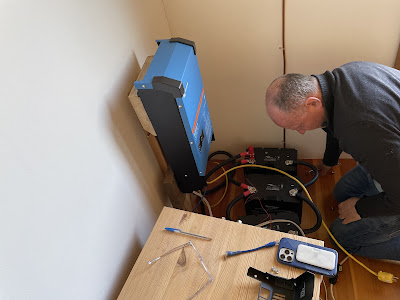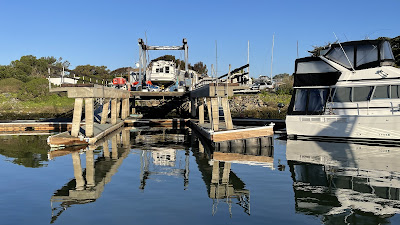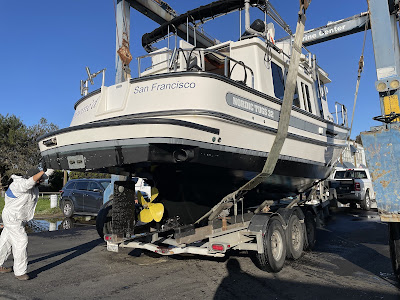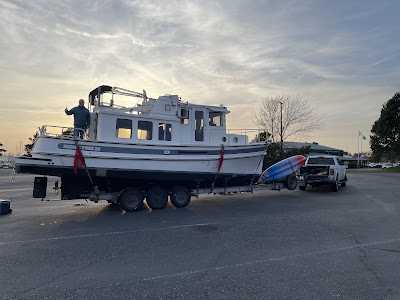 |
| Mike chopping firewood. |
Each year we stay at our cabin on Decourcy Island we make ourselves sore. We accomplish this by marching up the approx. 100ft./30 meters from our 15 sq. ft. dock up to the house. Every day. Multiple trips. Usually, we’re carrying groceries or propane canisters(1). Or fishing or prawning gear. For fun, we also walk from our house through the provincial park and back, a 1.5-hour light hike. I also get sore from hand-washing all the dishes and cooking. Mike, especially, does the back-breaking work.
We knew that staying at the cabin for a longer period than a 2-week vacation would challenge us in multiple ways. One way is to make us stronger and healthier. No more sitting all day. This is a primary retirement goal we share.
Check out these graphs from my My iPhone. It’s informing me of how much my activity has increased. My retirement began Oct. 1. Our stay at Decourcy began in mid-March.
 |
| Note the increases in activity to the right of the “O” (October) after retirement. And, coming to Decourcy in March, the “M” second from the right. |
The increased work began with moving boxes and luggage. There’s a lot of lifting goin’ on. Our Nordic Tug is too big for our little dock, so we’re temporarily keeping it in a slip in Pirate’s Cove marina, a 15-minute round trip walk. We have a vehicle(2), but the marina is so close we opt to smell the fresh air and walk if we don’t have anything heavy to carry. I’ve embedded myself with our wonderful, resident yoga instructor. That’s a 50-minute roundtrip walk to her beautiful house. When we get groceries in town we walk one half to a mile round-trip from a marina to the grocery store. There are doggie walks in the park. You get the picture.
I probably could have increased activity similarly by moving to New York City.
 |
| Soft, mossy trail through Pirate’s Cove Provincial Marine Park on Decourcy. |
The second retirement goal relates to challenging ourselves. Mike has challenged himself with many projects in the last few weeks. I’m gushing with pride for him. He has:
- Replaced the seized old metal wheels under our sliding glass door with shiny new ones. Did you know these can be replaced?
- Installed enough lithium batteries and an inverter(3) to power our Starlink system(4) and computer. And a TV. And charge hand tools like Maggie’s hair razor.
-Chainsaw basics: safety, maintenance, sharpening, and bucking(5) wood. All this courtesy of our neighbor, the resident expert and retired chainsaw professional.
-Created a burn pit(5). Digging and lining with heavy stones. It’s great entertainment to watch a bonfire. Can’t wait to have a weenie roast with guests during the burn season.
-Replaced our broken VHF antenna on the Nordic Tug.
-Installed a fog horn in case we encounter fog.
-Fixed our tug’s water level measurement system.
-Replaced our broken septic line.(6) Many of you heard the “shitty day” story we experienced last August. This is the happy ending. Knock on wood.
 |
| Mike installing 3 lithium batteries and a 3KW inverter/charger. |
 |
| The new burn pit! Mike spent a whole day digging and lining it with heavy rocks. |
Neighborhood experts and YouTube are enabling us to challenge ourselves to be as self-sufficient as we can be.
Holding back nothing from you, I sprained some upper back muscles when we were in Bellingham. It’s slowly getting better—slowly because I can’t escape all the lifting, I think.
We drop into bed each night exhausted. And satisfied.
Footnotes for Fun Fact Fans
(1) The canisters are identical to the ones you use in your bbq. We use propane to power our fridge, heat our water, cook, and heat our dryer.
(2) Our cabin came furnished with a vintage 1980s Suzuki Samurai. There are a few on Decourcy.
(3) Mike learned about inverters and safe wiring by doing this on our boat a few months ago. It enables us to use a few plug-in AC devices. Our existing solar/battery 12-volt system has a limited capacity (250AH). We use it for low energy-drawing LED lights, water pumps and USB charging. The battery-to-inverter-enabled system is charged by running our gas-powered generator for an hour or so. We plan to have a more robust system in a few years.
(4) The Starlink system is a major game changer. With Starlink, we have an internet connection all day. Streaming TV feels like cheating around here, but so be it! Without Starlink, our cell phone connection is undependable at the cabin.
(5) Bucking wood = chopping it up into wood stove-length pieces. Then Mike swings an axe to reduce the bucked pieces into firewood. We feed one modern wood stove to heat the cabin.
(6) Our black water system is a sewer pipe that runs to large, buried, 2 covered 50 gallon barrels that have holes. It works. Will likely modernize this system eventually.











